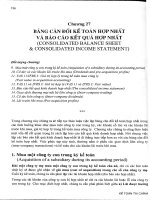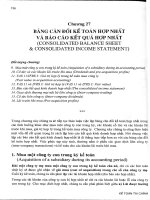Gíao trình kế toán bằng tiếng anh ch13
Bạn đang xem bản rút gọn của tài liệu. Xem và tải ngay bản đầy đủ của tài liệu tại đây (2.65 MB, 71 trang )
Chapter 13
Statement of Cash
Flows
Learning Objectives
After studying this chapter, you should be able to:
[1] Indicate the usefulness of the statement of cash flows.
[2] Distinguish among operating, investing, and financing activities.
[3] Prepare a statement of cash flows using the indirect method.
[4] Analyze the statement of cash flows.
13-1
Preview of Chapter 13
Managerial Accounting
Sixth Edition
Weygandt Kimmel Kieso
13-2
Statement of Cash Flows
Usefulness of the Statement of Cash Flows
Helps investors, creditors, and others to assess:
1. Entity’s ability to generate future cash flows.
2. Entity’s ability to pay dividends and meet obligations.
3. Reasons for difference between net income and net cash
provided (used) by operating activities.
4. Cash investing and financing transactions during the period.
13-3
LO 1 Indicate the usefulness of the statement of cash flows.
Statement of Cash Flows
Classification of Cash Flows
Operating
Activities
Income Statement
Items
Investing
Activities
Changes in
Investments and
Long-Term Asset
Items
Financing
Activities
Changes in LongTerm Liabilities and
Stockholders’
Equity Items
13-4
LO 2 Distinguish among operating, investing, and financing activities.
Statement of Cash Flows
Typical receipt and payment classifications
Illustration 13-1
Operating activities - Income statement items
Cash inflows:
From sale of goods or services.
From interest received and dividends received.
Cash outflows:
To suppliers for inventory.
To employees for services.
To government for taxes.
To lenders for interest.
To others for expenses.
13-5
LO 2 Distinguish among operating, investing, and financing activities.
Statement of Cash Flows
Typical receipt and payment classifications
Illustration 13-1
Investing activities - Changes in investments and long-term assets
Cash inflows:
From sale of property, plant, and equipment.
From sale of investments in debt or equity securities.
From collection of principal on loans to other entities.
Cash outflows:
To purchase property, plant, and equipment.
To purchase investments in debt or equity securities.
To make loans to other entities.
13-6
LO 2 Distinguish among operating, investing, and financing activities.
Statement of Cash Flows
Typical receipt and payment classifications
Illustration 13-1
Financing activities - Changes in long-term liabilities and
stockholders’ equity
Cash inflows:
From sale of common stock.
From issuance of long-term debt (bonds and notes).
Cash outflows:
To stockholders as dividends.
To redeem long-term debt or reacquire capital stock (treasury stock).
13-7
LO 2 Distinguish among operating, investing, and financing activities.
Statement of Cash Flows
Significant Noncash Activities
1. Direct issuance of common stock to purchase assets.
2. Conversion of bonds into common stock.
3. Direct issuance of debt to purchase assets.
4. Exchanges of plant assets.
Companies report these activities in either a separate schedule
at the bottom of the statement of cash flows or in a separate
note or supplementary schedule to the financial statements.
13-8
LO 2 Distinguish among operating, investing, and financing activities.
13-9
Statement of Cash Flows
Format of the Statement of Cash Flows
Order of Presentation:
Direct Method
1. Operating activities.
2. Investing activities.
Indirect Method
3. Financing activities.
The cash flows from operating activities section always
appears first, followed by the investing and financing sections.
13-10
LO 2 Distinguish among operating, investing, and financing activities.
Format of the Statement of Cash Flows
Illustration 13-2
13-11
LO 2
During its first week, Duffy & Stevenson Company
had these transactions.
13-12
Classification
1. Issued 100,000 $50 par value ordinary shares for
$8,000,000 cash.
Financing
2. Borrowed $2,000,000 from Castle Bank, signing a
5-year note bearing 8% interest.
Financing
3. Purchased two semi-trailer trucks for $1,700,000
cash.
Investing
4. Paid employees $120,000 for salaries and wages.
Operating
5. Collected $200,000 cash for services provided.
Operating
LO 2 Distinguish among operating, investing, and financing activities.
Preparing the Statement of Cash Flows
Three Sources of Information:
1. Comparative balance sheets
2. Current income statement
3. Additional information
Three Major Steps:
13-13
Illustration 13-3
LO 2
Preparing the Statement of Cash Flows
Three Major Steps:
13-14
Illustration 13-3
LO 2
Statement of Cash Flows
Indirect and Direct Methods
Indirect
Indirectmethod
method
Direct
Directmethod
method
Adjusts
Adjustsnet
netincome
incomefor
foritems
items
that
thatdo
donot
notaffect
affectcash.
cash.
Shows
Showsoperating
operatingcash
cash
receipts
receiptsand
andpayments,
payments,
making
makingititmore
moreconsistent
consistentwith
with
the
theobjective
objectiveof
ofaastatement
statementof
of
cash
cashflows.
flows.
The FASB has expressed a
preference for the direct
method, but allows the use of
either method.
13-15
LO 2 Distinguish among operating, investing, and financing activities.
Statement of Cash Flows
Indirect and Direct Methods
Companies favor the indirect
method for two reasons:
1. It is easier and less costly to
prepare, and
2. It focuses on the differences
between net income and net cash
flow from operating activities.
13-16
LO 2 Distinguish among operating, investing, and financing activities.
Preparing the Statement of Cash Flows
Indirect
Method
13-17
Illustration 13-4
LO 3 Prepare a statement of cash flows using the indirect method.
Preparing the Statement of Cash Flows
Indirect
Method
13-18
Illustration 13-4
LO 3 Prepare a statement of cash flows using the indirect method.
Preparing the Statement of Cash Flows
Illustration 13-4
Additional information for 2014:
1. Depreciation expense was comprised of $6,000 for building and $3,000 for equipment.
2. The company sold equipment with a book value of $7,000 (cost $8,000, less accumulated
depreciation $1,000) for $4,000 cash.
3. Issued $110,000 of long-term bonds in direct exchange for land.
4. A building costing $120,000 and equipment costing $25,000 were purchased for cash.
5. Issued common stock for $20,000 cash.
6. The company declared and paid a $29,000 cash dividend.
13-19
LO 3
Preparing the Statement of Cash Flows
Step 1: Operating Activities
Indirect
Method
Determine net cash provided/used by operating activities by
converting net income from an accrual basis to a cash basis.
Common adjustments to Net Income (Loss):
13-20
Add back non-cash expenses (depreciation and amortization
expense).
Deduct gains and add losses.
Changes in non-cash current assets and current liabilities.
LO 3 Prepare a statement of cash flows using the indirect method.
Preparing the Statement of Cash Flows
Question
Which is an example of a cash flow from an operating
activity?
a. Payment of cash to lenders for interest.
b. Receipt of cash from the sale of capital stock.
c. Payment of cash dividends to the company’s
stockholders.
d. None of the above.
13-21
LO 3 Prepare a statement of cash flows using the indirect method.
Step 1: Operating Activities
Determine Net Cash Provided/Used By
Operating Activities By Converting Net Income
From An Accrual Basis To A Cash Basis
Under the accrual method:
Earned revenue may include credit sales for which the
company has not yet collected cash.
Expenses incurred may include some items that it has not yet
paid in cash.
Therefore net income is not the same as net cash provided by operating
activities. Under the indirect method, companies must adjust net income
to convert certain items to the cash basis.
13-22
LO 3 Prepare a statement of cash flows using the indirect method.
Step 1: Operating Activities
Determine Net Cash Provided/Used By
Operating Activities
Illustration 13-5
13-23
LO 3 Prepare a statement of cash flows using the indirect method.
Step 1: Operating Activities
Depreciation Expense
Although depreciation expense reduces net income, it does not
reduce cash. Depreciation is a noncash charge. The company
must add it back to net income.
Illustration 13-6
13-24
LO 3 Prepare a statement of cash flows using the indirect method.
Step 1: Operating Activities
Loss on Sale of Equipment
Because companies report as a source of cash in the investing
activities section the actual amount of cash received from the
sale companies must eliminate from net income all gains and
losses by:
13-25
Adding any loss on sale to net income in the operating
section.
Deducting any gain on sale from net income in the operating
section.
LO 3 Prepare a statement of cash flows using the indirect method.









